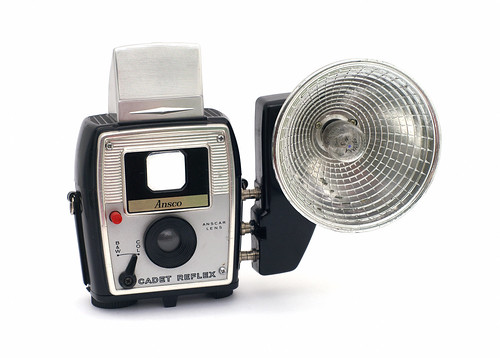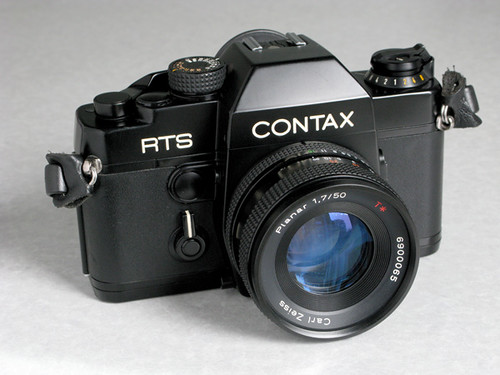Others of you may have been also seeing the photos I have been posting on my photo blog, and that brings us to the reason for today's post.
Ever since the time I was a youngster, I have loved taking pictures. My first camera was an Ansco Cadet Reflex which took 127 size film. At first, I used whatever film my parents bought for me, and in the early 1960's most people were still using black and white film. I was young, and thought that if I moved the selector on the front of the camera from B&W to COL I would get color photos. I soon found out that you actually needed to use color film. (I told you I was young!) I got it prior to 1964, but in April of that year, I bought my first roll of color film and exposed it at the NY World’s Fair. You very rarely saw me without my camera. (Over the years I would use many different cameras from a very small 110 size camera, to a disk film camera, a few different models of Polaroid instant print cameras and even a Kodak instant print camera. The last one I actually got paid by Kodak to stop using when they lost a lawsuit to Polaroid! I even had an underwater camera.) I soon set up a darkroom, and a contact printer. It wasn’t until I was married that I would actually have an enlarger.
By that time, my camera was a 35mm Contax RTS, a Single Lens Reflex (SLR) camera. It would remain my camera until the age of digital photography was upon us. I took the camera everywhere and spent hours in the darkroom. Many of my prints got submitted into contests and publications and every so often I would hit the jackpot. In fact, at the very moment I was talking with President Jimmy Carter, an editor was placing one of my pictures into a magazine to go along with one of my articles.
I also had a Yashica Mat 124G Twin Lens Reflex (TLR) large format camera which I used for portraits and the occasional wedding/bar mitzvah shoot.
After my daughter was born, however, the darkroom reverted back to our kitchen, and while I still took a lot of pictures, they were more of the snapshot variety that dads tend to take of their kids.Today they are the type that a grandpa takes of the grandtwins. (And quite a few of Disney World!)
But recently I have seen a number of my friends posting their pictures and the old urge to go take pictures for the sake of taking them hit me hard. I had been using point and shoot cameras in this age of digital photography, but I missed using my old SLR and the flexibility it afforded me. I also missed going out and taking photos for the sake of taking interesting photos. So it was time to move up to a Digital SLR (DSLR). I recently purchased a Nikon D3100 and thought I could pick up where I left off with the Contax RTS.
In many ways I could, and did, but in many ways I found myself totally perplexed when I first got the camera in hand. My Contax RTS, state of the art for the early 1970's when I bought it, had internal metering (though you still had to manually set the aperture and shutter) and an electronic shutter - something new in the photography world in those days. Other than that, it was a totally manual camera. No auto-focus or any of the other fancy electronic features of today's cameras. As for the ISO speed (called ASA back then), that was controlled by the film you were using. You couldn't change it to accommodate changing conditions unless you changed the film in the camera. As it was, you generally had to change film after every 36-40 shots anyway.
But now I found myself having to learn all the new bells and whistles of the electronic, digital age of photography. The basic tenants of photography still remain the same, and I still (mostly) shoot in Aperture Priority mode, which is what I did on my old Contax RTS, although it wasn't a "mode" back then, it was a technique. The only "modes" the camera had were "on" and "off", and they occurred when you used the camera - or didn't.
So once again I am enjoying the art of photography and seeing the world through a photographer's eyes. When I finish this post, I will be grabbing my camera and heading out to see what I can photograph today. You can see some of what I have taken so far on both of the blogs listed at the beginning of this post. Your comments are not only welcome, but very appreciated. Feel free to critique them and remember that each person looks at things in different ways and sees different things in the same view. Your opinions are welcome and I hope I can continue to grow as a photographer upon hearing your thoughts.





Exciting to have a new camera and be inspired to look at the world with fresh creative eyes again. I don't have a DSLR but my compact zoom has so many features I haven't yet explored. There's so much I love about digital over film.
ReplyDeleteWould be fun to see what you have learned along the way Mark. What are your findings after 2 years and what are you using at the moment. I´m no expert at all and still learning to figure out my own camera! just interested :-) ( Carol van Mourik 365 days in nature )
ReplyDeleteGood question Carol. I think the number one thing I learned, was something I knew from the beginning. Despite all the bells and whistles on new cameras, the basics of photography stays exactly the same ... composition and exposure. You could be using a pinhole camera or the most expensive technical marvel but it all boils down to composition and exposure. The new cameras give you updated ways to control that - but a good photographer can take good photos on any piece of equipment ... and the most expensive piece of equipment won't take a good photo without the eye of a photographer behind it. "Good" equipment is as capable of taking a bad photo as inexpensive equipment is of taking a great photo. It's all up to the photographer. (See my post here ... http://imagegatherer.wordpress.com/2012/04/25/you-must-have-a-great-camera/ )
Delete